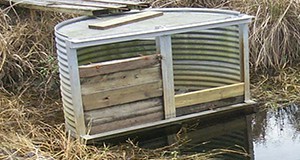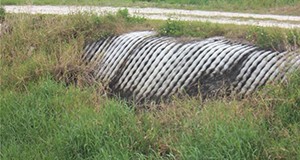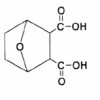 Water discharge structures are used to control water table levels and surface water levels in drainage and irrigation ditches within flatwoods citrus groves. The type of structure selected can significantly influence the quality of water discharged. With flashboard risers, water is forced to flow over the top board. This flow path creates a low current area toward the bottom, which facilitates the deposition of sediments and their accompanying nutrients or pesticides, essentially removing them from the discharges. Conversely, screw-gate structures do not create this dead-current zone. Since they open from the bottom, sediments are swept out along with the discharge water. Written by Chris Wilson, Liberta Scotto, Brian Boman, and Tim Gaver. Original publication date February 2002. Revised April 2012 and August 2015.
Water discharge structures are used to control water table levels and surface water levels in drainage and irrigation ditches within flatwoods citrus groves. The type of structure selected can significantly influence the quality of water discharged. With flashboard risers, water is forced to flow over the top board. This flow path creates a low current area toward the bottom, which facilitates the deposition of sediments and their accompanying nutrients or pesticides, essentially removing them from the discharges. Conversely, screw-gate structures do not create this dead-current zone. Since they open from the bottom, sediments are swept out along with the discharge water. Written by Chris Wilson, Liberta Scotto, Brian Boman, and Tim Gaver. Original publication date February 2002. Revised April 2012 and August 2015.
https://edis.ifas.ufl.edu/ss409
Tag: P. Christopher Wilson
Flatwoods Citrus Best Management Practice: Soil Stabilization

This best management practice describes stabilization practices for erosion-prone soils within flatwoods citrus groves. Significant amounts of soil may be deposited in drainage ditches and canals because of the erosion of grove soils. These deposited soils reduce the capacity for holding and transporting water. Plus, very small soil fractions may be suspended in discharge water then settle out in slower flowing areas and destroy submerged aquatic habitats, resulting in the loss of fish, invertebrate, and plant species important for healthy ecosystems. Fortunately, a variety of slope stabilization methods are available. This publication describes considerations for using plants for stabilization, or mulch-like materials. Written by P. Chris Wilson, Liberta Scotto, Brian Boman, and Tim Gaver. Original publication date March 2002. Revised April 2012 and August 2014. Reviewed August 2015.
http://edis.ifas.ufl.edu/ss408
Aquatic Toxicology Notes: Endothall (SL369/SS570)
 Endothall is the herbicidal active ingredient found in commercial formulations labeled for weed control in aquatic systems and on ditch banks. It is also used as a defoliant and desiccant in some terrestrial situations (e.g., in potato, hops, cotton, clover, and alfalfa production). This 7-page fact sheet introduces users of endothall to the physical, chemical, environmental, and ecological properties of this herbicidal active ingredient relative to the aquatic environment. Written by P. Chris Wilson and Jun Wu, and published by the UF Department of Soil and Water Science, October 2012.
Endothall is the herbicidal active ingredient found in commercial formulations labeled for weed control in aquatic systems and on ditch banks. It is also used as a defoliant and desiccant in some terrestrial situations (e.g., in potato, hops, cotton, clover, and alfalfa production). This 7-page fact sheet introduces users of endothall to the physical, chemical, environmental, and ecological properties of this herbicidal active ingredient relative to the aquatic environment. Written by P. Chris Wilson and Jun Wu, and published by the UF Department of Soil and Water Science, October 2012.
http://edis.ifas.ufl.edu/ss570
Aquatic Toxicology Notes: Diquat (SL368/SS569)
 Diquat is applied directly to plants along ditch banks and within aquatic systems. It may also be applied to ponds, lakes, and drainage ditches to control algae and submersed aquatic weeds. This 7-page fact sheet introduces users of diquat to the physical, chemical, environmental, and ecological properties of this herbicidal active ingredient relative to the aquatic environment. Written by P. Chris Wilson and Jun Wu, and published by the UF Department of Soil and Water Science, October 2012.
Diquat is applied directly to plants along ditch banks and within aquatic systems. It may also be applied to ponds, lakes, and drainage ditches to control algae and submersed aquatic weeds. This 7-page fact sheet introduces users of diquat to the physical, chemical, environmental, and ecological properties of this herbicidal active ingredient relative to the aquatic environment. Written by P. Chris Wilson and Jun Wu, and published by the UF Department of Soil and Water Science, October 2012.
http://edis.ifas.ufl.edu/ss569
Water Quality Notes: Alkalinity and Hardness (SL332/SS540)
The terms alkalinity and hardness are often used interchangeably when discussing water quality. These aggregate properties of water share some similarities but are distinctly different. This 7-page fact sheet describes alkalinity and hardness, their importance from management and ecological perspectives, methods for measuring each, and the current state regulations for each in public waters of Florida. Written by P. Chris Wilson and published by the UF Department of Soil and Water Science, October 2010.
http://edis.ifas.ufl.edu/ss540
Water Quality Notes: pH (SL328/SS538)
Water pH is one of the most common water quality measurements made because it influences a myriad of chemical, physical, and biological processes. The pH of water in an aquatic system is one of the most important water quality parameters because it dramatically influences the bioavailability of some nutrients, metals, and pesticides to plants and animals. This 8-page fact sheet describes water pH, the importance of pH from ecological and management perspectives, common methods used to measure pH, and current state regulations for pH in public waters of Florida. Written by P. Chris Wilson, and published by the UF Department of Soil and Water Science, March 2011.
http://edis.ifas.ufl.edu/ss538
AE248 Fertilizer Application Best Management Practices for Citrus Grove Workers
Revised! AE248, a 12-page fact sheet by Brian Boman, Darren Cole, Steve Futch, Ward Gunter, Jack Hebb, and Chris Wilson, instructs citrus grove workers in fertilizer application best management practices. Includes references and quizzes throughout. Published by the UF Department of Agricultural and Biological Engineering, March 2009.
http://edis.ifas.ufl.edu/ae248
SL313/SS525 Water Quality Notes: Dissolved Oxygen
SL313, an 8-page illustrated fact sheet by P. Chris Wilson, provides an overview of dissolved oxygen (DO) from a chemical, physical, and ecological perspective and summarizes common analytical methods for measuring DO, state regulations, and management options. Includes glossary and references. Published by the UF Department of Soil and Water Science, January 2010.
http://edis.ifas.ufl.edu/ss525
SL314/SS526 Water Quality Notes: Water Clarity (Turbidity, Suspended Solids, and Color)
SL314, a 9-page illustrated fact sheet by P. Chris Wilson, provides an overview of water clarity and how it is influenced by the presence of turbidity, suspended solids, and color
and discusses ecological significance of water clarity, measurement, state regulations, and management options. Includes glossary and references. Published by the UF Department of Soil and Water Science, January 2010.
http://edis.ifas.ufl.edu/ss525
AE246 Herbicide Application Best Management Practices for Citrus Grove Workers
Revised! AE246, a 13-page illustrated fact sheet by Brian Boman, Darren Cole, Steve Futch, Ward Gunter, Jack Hebb, Chris Wilson, is part of the Best Management Practices (BMPs) for Citrus Grove Workers series. It covers personal protective equipment, tractor and herbicider preventive maintenance, mixing and loading, posting, important stepts to take before application, herbicide application, equipment clean up, and spill containment. Includes three comprehension quizzes and references. Published by the UF Department of Agricultural and Biological Engineering, March 2009.
http://edis.ifas.ufl.edu/AE246
ABE367/AE243 Understanding the Pesticide Label for Citrus Grove Workers
Revised! ABE-367, a 5-page fact sheet by Brian Boman, Darren Cole, Steve Futch, Ward Gunter, Jack Hebb, Chris Wilson, is part of the Best Management Practices (BMPs) for Citrus Grove Workers series. It emphasizes the importance of reading pesticide labels, the risks of misusing pesticides, and what is on the label. Includes a 10 question quiz and references. Published by the UF Department of Agricultural and Biological Engineering, March 2009.
http://edis.ifas.ufl.edu/AE243
ENH1088/EP358 Remediation of Runoff: Options for Container Plant Nurseries
ENH-1008, a 6-page illustrated fact-sheet by J. Sharma, P.C. Wilson, and T.H. Yeager, describes the problem of non-point source pollution from container nurseries, and plant-based and non-plant based options for remediation. Includes references. Published by UF Department of Environmental Horticulture, January 2008.
http://edis.ifas.ufl.edu/EP358